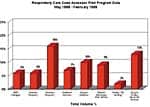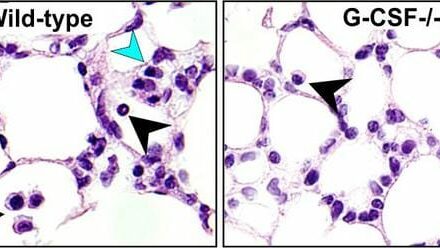Therapists are attracted to the University of Texas Medical Branch at Galveston for its reputation in providing state-of-the-art technology and its commitment to education and research.

“The scope of practice we do here sets us apart from many other institutions,” explains Dennis Hastings, RRT, RCP, director of Pulmonary Care and Anesthesia Support Services. “We’ve gone from being a task-oriented department to being relied on heavily by physicians and other staff for our clinical advice.”
With a total of 105 full-time employees in the department and more than 13,000 employees hospital-wide, UTMB is the third-largest employer in the greater Houston area. Patients come from throughout the state, nation, and the world to receive care at the 760-bed teaching hospital. Specialized care areas of the UTMB Hospitals include the infant special care unit, cardiothoracic surgery division with an extracorporeal membrane oxygenation (ECMO) regional center, neurological trauma center, burn service with human skin bank, cancer center, and renal service—including kidney dialysis and renal transplantation program. UTMB is also a recognized leader in other transplantation programs, such as pancreas, liver, heart, lung, and heart-lung procedures.
UTMB currently has nine intensive care units (ICUs). Approximately 2,300 patients were treated in these ICUs in 2000, and the institution was recently named one of the 100 Top Hospitals/ICUs in an independent study released by Evanston, Ill-based Solucient Leadership Institute. UTMB was the only teaching hospital in Texas to receive the distinction.
“Therapists who want experience in a variety of areas and who are adaptable to new experiences do very well here, “ notes Linda Willems, RRT, RCP, education coordinator.
A Brief History
The Pulmonary Care Services Department was developed 11 years ago. In a short time, it went from being a very small, somewhat unrecognized unit to becoming a high-level, highly visible patient care department. In the early years of the department, the respiratory staff consisted of primarily certified technicians; within a few years, however, the majority were either registered or registry-eligible therapists. “In the past 5 years, the department has broadened its scope, and we’re now actually five departments under one umbrella,” Hastings says. The departments include Pulmonary Care Services, Anesthesia Support Services, pulmonary function laboratory, bronchoscopy laboratory, and sleep laboratory.

The 12-story John Sealy Hospital is the hub of UTMB’s inpatient care system. The other hospitals included in the network are Children’s Hospital, John Sealy Annex, Rebecca Sealy Hospital, R. Waverly Smith Pavilion, and the Texas Department of Criminal Justice (TDCJ) Hospital, operated jointly by TDCJ and UTMB. The only one of its kind in the country, the TDCJ 204-bed hospital includes a 12-bed ICU. UTMB has an exclusive managed care contract with TDCJ to care for all inmates in the state of Texas. Under this contract, care is provided through UTMB’s inpatient facilities as well as outpatient clinics via telemedicine. The Shriners Burn Hospital, operated by the Shriners of North America, is a UTMB-affiliated center that provides free treatment to pediatric burn patients from around the world. Special outpatient facilities at UTMB include the Primary Care Pavilion and the Geriatric Day Hospital.
RTs are assigned to specific areas such as the operating room (OR), trauma center, TDCJ prison hospital, neonatal/pediatric services, or adult critical care services. A separate team of clinical specialists oversees the various disciplines in the clinical environment and the outpatient clinics. “Our therapists have opportunities to cross-train into other specialized areas,” Willems says. “We have therapists who are ECMO specialists, hyperbaric technologists, and anesthesia support personnel.” She adds that training is always available to therapists who are motivated in advancing their skill levels and they work 12-hour shifts.
A Plethora of Opportunities
Hastings points out that the variety of jobs is one of the major attractions of working at UTMB. “Our patient population runs the gamut from premature neonates to geriatric patients,” he says. “Therapists have the opportunity to take on many different roles.” In Pulmonary Care Services alone, between 65,000 and 70,000 patients are treated annually. Furthermore, the inpatient hospital typically has an average 90% census with Pulmonary Care Services seeing about 40% of these patients on a daily basis.

UTMB was also the first hospital in the United States to offer an anesthesia certification program for therapists. “We currently have a core group of 13 individuals who work in the OR assisting the anesthesiologist,” Hastings says. In addition, the therapists assist in preparing ORs for complex anesthesia procedures, set up anesthesia equipment, handle and clean special equipment, maintain inventory records, and order, store, and distribute anesthesia supplies, drugs, and equipment. Some of these individuals perform more advanced functions such as electrocardiography, prescreening, blood drawing, intubations under the direction of the anesthesiologist, trouble-shooting, autotransfusion (cell saver), blood gas analysis, ventilation support, and IV starts.
The anesthesia technician in-service training program takes approximately 6 months to 1 year to complete. All of UTMB’s respiratory staff are required to go through this program and must sit for the national certification for anesthesia technician.
A Commitment to Technology
With such a diverse and critically ill patient population, UTMB’s administrators are strongly committed to technology acquisition. The Pulmonary Care Services Department has a reputation for having the latest state-of-the-art equipment and has spent more than $2 million during the past 2 years upgrading its technology. “We definitely have one of the best inventories of equipment compared to many other hospitals,” Hastings says.

According to Hastings, the department uses the same type of ventilator, whether the patient is a neonate or a 500-pound burn patient. “We went from using six different types of ventilators to one, which has positively impacted training, ventilator maintenance, and repair,” Hastings says. Interestingly, since switching to one type of ventilator, the hospital’s overall length of stay for patients on ventilators was reduced by about 8% to 10%. “Not only did the rate of time on ventilators decrease for patients, but the overall length of stay in the ICU also decreased,” Hastings says. This accomplishment was even recognized by USA Today, which named UTMB as one of the top 16 hospitals in the country to have residency programs for reducing overall length of stay in ICUs, cost of care in those units, and mortality and morbidity rates.
Many services that the department oversees are not commonly assigned to RTs in other teaching hospitals. This partially stems from the fact that UTMB therapists have become recognized hospital-wide as technical experts. For instance, the department is responsible for maintaining the code carts throughout the hospital by cleaning and restocking the carts once they have been used in a code situation. An airway management system to coordinate supplies for intubations is also handled by the department. Airway management stations are scattered throughout the hospital system to make this more efficient.
Pulmonary Care Services is currently in the process of converting its traditional type of oxygen for transporting patients from cylinders to liquid oxygen. The defibrillator fleet was also recently upgraded, and the department just took over all pulse oximetry monitoring in the hospital, which led to the acquisition of new oximeters. RTs also maintain and utilize the equipment for seven satellite blood gas laboratories in different ICUs.
Therapist-Driven Protocols
Therapist-driven protocols have probably had the largest impact on the expanding role of RTs at UTMB. The most successful has been the department’s oxygen administration protocol, which allows therapists to titrate oxygen levels based on a patient assessment and oximetry evaluation. “Therapists are basically allowed to make changes in oxygen administration without a physician’s order,” Hastings says. “We give our therapists a lot more autonomy for managing ventilators than other institutions.”
Another protocol that has been in place for a few years is used with bronchodilator administration and allows therapists to convert patients currently on nebulizers to meter-dose inhalers. A protocol was also established for chest physiotherapy, which permits therapists to select either chest physiotherapy or positive expiratory pressure therapy for individual patients. The department is currently working with a multidisciplinary team to develop ventilator management protocols.
According to Hastings, the value of the protocols is that they have given therapists a greater role in patient care. “Therapists are now required to be assessors and evaluators, compared to the past when we simply were given an order and were expected to follow through on it,” he says.
Research Opportunities
Research opportunities have also attracted many RTs to UTMB. One of the largest ongoing studies involves AVCOR, a simplified ECMO process that is used strictly for CO2 removal in patients with acute lung injury. Another research project is the development of an artificial lung. Presently in the laboratory animal stage, the project, Hastings explains, “involves creating a system that provides oxygenation and CO2 elimination externally from the patient, but at the same time uses the patient’s own cardiac function to drive blood flow.” This project is expected to go to human trials in the near future.
According to Hastings, the liquid oxygen program is one of the department’s most exciting and important research projects. Patient trials have been conducted since March 2000, and rooms are currently being constructed to house the liquid oxygen reservoirs throughout the hospital. “This project started out as a solution to a patient safety issue, and then it became apparent that it was also a cost-containment issue,” Hastings says. The conversion to liquid oxygen, which is expected to be completed this spring, will save the hospital about $100,000 in operating costs.
| UTMB at Galveston
• With a total of 103 FTEs in the department and more than 13,000 employees hospital-wide, UTMB is the third-largest employer in the greater Houston area. • RTs are assigned to specific areas such as the OR, trauma center, neonatal/pediatric services, or adult critical care services. • There are nine ICUs and approximately 2,300 patients were treated in them in 2000. • In Pulmonary Care Services alone, between 65,000 and 70,000 patients are treated annually. |
A Commitment to Education
Another unique aspect of Pulmonary Care Services is that the hospital is owned by the University of Texas System, which provides many educational opportunities to therapists. The medical school has three separate divisions: the School of Medicine, the School of Nursing, and the School of Allied Health. Within the School of Allied Health, the Department of Respiratory Care offers a bachelor of science degree for applicants entering the field and for registered RTs. Students in these programs can obtain all of the clinical training at UTMB, as opposed to having to rotate through multiple institutions, which can be inconvenient.
“Our employees can work here and receive financial reimbursement and adjustable work schedules while pursing a higher degree,” Willems says. “Our therapists have advanced to receive bachelor’s and master’s degrees in a variety of areas, and then went on to become physician assistants, registered nurses, and, in one instance, a physician.”
Therapists within Pulmonary Care Services are encouraged to obtain their bachelor’s degree. “Currently, we hire only registered, registry-eligible therapists, or certified respiratory therapists who make a commitment to becoming registry-eligible within 18 months,” Willems says.
Pulmonary Care Services also offers two 2-day educational seminars each year for therapists. In the fall, a pediatric-oriented program is offered for 12 CEUs and in the spring, a program for adult patients is offered for 12 CEUs.
As many hospitals throughout the country have struggled to stay afloat financially, UTMB has been successful in maintaining a healthy bottom line. Hastings attributes that to a cost-containment period during the past 2 years that streamlined many internal processes. “We’ve really taken a hard look at ourselves in terms of how we do business and have made many necessary improvements,” he says. “We’ve actually been able to reduce our overall operating budget by about $1 million a year without jeopardizing patient care or the operation of the department itself. We’re leaner like a lot of other hospitals, but we have also succeeded in keeping our operations intact while expanding our services at the same time.”
Carol Daus is a contributing writer for RT Magazine.









